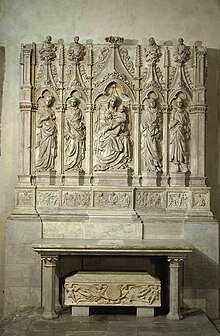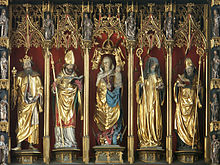Richard of Wessex

Richard of Wessex , also Richard the Saxon , Richard the King , Richard of England , Richard of Lucca , Richard of Swabia or Richard the Pilgrim is a Christian saint whose veneration began in the 12th century. During this time, an Anglo-Saxon pilgrim by the name of Richard, who was buried in Lucca, is associated with the nameless father of the saints Wunibald , Willibald and Walburga who died there in 720 . All four are diocese saints of the diocese of Eichstätt . From this the legend develops that this Richard is said to have been King of West Saxony in Wessex in the early years of the 8th century . He is traditionally regarded as the brother-in-law of Wynfreth, who received the name Bonifatius from Pope Gregory II in 719 and who evangelized as an apostle of the German Germania. Legend has it that his property was expropriated because he refused to resign. His wife of unknown name has been venerated as holy Wuna (or Wina) since the late Middle Ages .
Historical sources
The "nameless" father in the vita of the nun Hugeburc
The biographies of the brothers Willibald and Wunibald contain little information about their father. The biography of Willibald has a high historical value because the author, a nun in the Heidenheim monastery named Hugeburc , writes the report according to her own statement during Willibald's lifetime after his dictation. She names 23 June 778 as the date. The unnamed father tells us that he owned a manor in the southern English county of Wessex. He was one of the free, well-to-do landowners from whom the nobility later developed. In 720 he gives in to the insistence of his son Willibald and goes on a pilgrimage to Rome and the Holy Land with the two sons . During the trip he died in Lucca, Tuscany, between May and November 720. In Willibald's life story it says: "In the further course they came to a town called Lucca. Willibald and Wunibald had their father with them in the tour company. An unexpected one met him there afflicted physical weakness, so that after some time the day of his death was imminent. As the severe illness increased in him, the tired and cold limbs of his body were already consumed and he breathed out the last breath of his life. Immediately his faithful sons took him decoiled her father's body in reverent love, carefully wrapped it up and buried it in the earth. That was in the city of Lucca near St. Frigidianus ( San Frediano ). There the body of her father rests. " We meet the father again in Willibald's biography 20 years later. Shortly after Easter 740, Willbald visited the grave on the way from Rome to Germania, where Pope Gregory III took him. had sent to missionary work at the request of Boniface.
The discovery of the Richard relics in the report of Abbot Adalbert von Heidenheim
Only more than 400 years later is there a reference to the father of the three holy brothers and sisters in the reports of Abbot Adalbert von Heidenheim about reforms in his monastery around 1160 . Abbot Adalbert reports on a delegation from the diocese of Eichstätt, who asked around 1150 in Lucca for relics of the deceased father of the diocese saint. The citizens of Lucca, now informed about the true worth of their previously little-noticed pilgrim named Richard, collected the relics with papal permission and placed them in an altar on February 7th, which according to the opinion of the time corresponded to a canonization. That is why his festival is still celebrated on this day. After paying a larger amount, the Eichstätt were able to take some insignificant relics with them and as a result, the memorial day of St. Richard was introduced in the diocese of Eichstätt. A member of the Eichstätter delegation to Lucca is named in the reports, namely Ilsung, a canon of the Heidenheim monastery . He seems to have had at least part of the Richard relic in his possession. Always on the feast of St. Wunibald and at Christmas he brought the relics to Heidenheim on horseback. This Ilsung is mentioned in a document from 1180 as pastor of Otting , which could explain that exactly there the only one dedicated to St. Richard consecrated church in the diocese of Eichstätt exists.
Legend formation in the Willibald biography of Bishop Philipp von Rathsamhausen
In the biography of Saint Willibald by Bishop Philipp von Rathsamhausen (1305–1322), created around 1308/1309, the unnamed father, who was then associated with the pilgrim Richard, became the "King of England" and the "Duke of Swabia". As a result, the coat of arms of the English kings from the House of Anjou-Plantagenet - three striding leopards or lions on a red background - was transferred to Richard and his children and later also to the Heidenheim Abbey, the St. Walburg Monastery in Eichstätt and the Eichstätter cathedral chapter passed over. Phillip von Rathsamhausen also describes some miracles that are said to have taken place at Richard's grave.
literature
- Andreas Bauch (Hrsg.): "Sources for the history of the Diocese of Eichstätt", Volume I: Biographies of the founding period (Eichstätter Studies, New Volume 19), Regensburg, 2nd edition 1984
- Richard Baumeister: Richard and Wuna (7th / 8th century). The parents of the diocese patron . In: In the splendor of the holy. Holy, blessed and venerable persons from the diocese of Eichstätt. Willibaldverlag Eichstätt 2010. ISBN 978-3-9813219-1-3
- Thomas Meyrick: Family of St. Richard, the Saxon . With a foreword by John Henry Newman . Toovey, London 1844 ( digitized version )
Web links
Individual evidence
- ↑ Codex latinus monacensis 1086 of the Munich State Library, published in MGH SS XV.
- ↑ Richard Baumeister: Richard and Wuna (7th / 8th century). The parents of the diocese patron , 47–48.
| personal data | |
|---|---|
| SURNAME | Richard of Wessex |
| ALTERNATIVE NAMES | Richard the Saxon; Richard the King; Richard of England; Richard of Lucca; Richard of Swabia; Richard the Pilgrim |
| BRIEF DESCRIPTION | West Saxon King in Wessex and Saint |
| DATE OF BIRTH | 7th century |
| DATE OF DEATH | 8th century |


